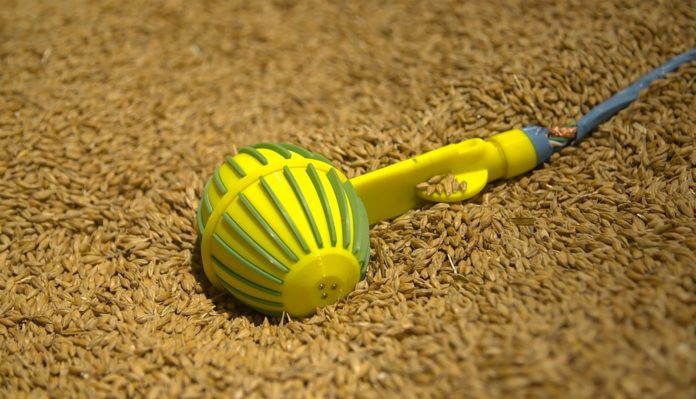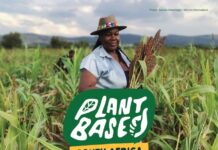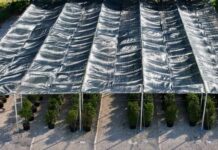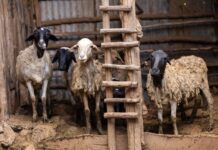We are living in an era of seismic challenges. Our global food system faces stresses we’ve never seen before; from the climate crisis, population growth and fractured supply chains. But might the shock to our system be a catalyst for positive change?
BBC World News and bbc.com series Follow the Food goes on a journey to witness how farmers, scientists and innovators, are radically reimagining how we grow our food, and how we produce it. It’s a quest to meet the greatest challenges that are facing humanity, and create a new and better food future.
In this episode, we explore what innovators are doing to improve our food systems and prevent valuable ingredients and resources from going to waste.
Food loss vs food waste
There are huge food distribution centres all over the world, where foods from the four corners of the planet are then sent to restaurants, retailers and people at home. But, each year, up to 40% of the food in these centres – through food loss and food waste – end up in the bin. To put that into numbers, it has been estimated that 1.3 billion tonnes of food produced for human consumption never gets eaten. One third of all the calories created, costing approximately US$2.6 trillion annually are going to waste.
Many people have argued that if we could simply find solutions to this enormous, global problem we could solve world hunger because we already produce enough food to feed the planet’s population. But where within our food chain does this loss and waste occur?
Pete Pearson, Senior Director for Food Loss and Waste at the World Wildlife Fund says: “The differences between ‘food loss’ and ‘food waste’ is that food loss is characterized as the losses that happen at the beginning of the supply chain, such as losses on farms, or on transport as you’re distributing product. Food waste is more on the consumption side. For example, maybe it’s a banquet that over-prepares so much food they have to throw it away, so waste is consumption that’s gone awry.
“One of the biggest things we need to realise is that this loss and waste goes largely unmeasured – we don’t report on it. If we measure it, we’d better inform ourselves and start to understand the true impact that food has on the planet. When we measure loss and waste in the food chain, we identify the opportunities to save money and become more profitable. Waste does not exist, it’s a human construct. We have created the idea of waste because, in nature, nothing is wasted, everything is circular.
“It’s about the decisions that humans make that can prevent loss and waste if we design things better, if we develop better partnerships. If all of the actors in the supply chain take responsibility for food loss and waste, then we can really make a difference.”
Food loss on the farm
The first stage of the waste chain is the farm. Here, any number of hazards can put a farmer’s hard work at risk of being wasted – from pests and diseases to extreme weather. Even for crops that successfully survive the harvest, there’s still a risk of food loss when in storage.
Robert Neill runs a 544 hectare cereal farm in the Scottish borders. Each year, storing his harvest comes with a giant risk.
With 3000 tonnes in his store, much of his harvested grain is being stored for long periods of time, and protecting it is an ongoing battle. 20-30% of harvested grain is lost during storage because maintaining optimum temperature and moisture levels for grain in these stores is a fine art.
“These dried seeds can be stored here indefinitely, as long as they’re stored in the correct manner. It needs to be below 14% moisture otherwise mould can start growing, the seed starts to heat, and then germination takes place. There’s a whole host of reasons that could lead the grains to being rejected, and then I’ve lost thousands of pounds,” said Robert.
Regular testing for temperature and humidity in stored grains is a laborious process using what’s known as a grain spear. Like a hypodermic needle, farmers need to push the needle right to the centre of the pile to take a sample, as it’s the core that’s vulnerable. Once collected from the centre, the grain is loaded into a monitor to make sure the moisture is no higher than 14% when it enters the food chain. It’s so labour intensive that Robert is working with a team on a cutting edge solution.
Dr Lorenzo Conti is the founder and developer of Crover, a time-saving tool that can reduce the losses suffered in grain stores. He has invented the world’s first granular drone that can move through cereals whilst measuring the temperature and moisture of the entire pile to identify critical hotspots.
Its burrowing mechanism works by using fins that come in and out and can twist in independent directions. It’s controlled through an app, where the conditions within the pile of grain are mapped and any problems can be easily identified, in a way that is similar to a 3D ultrasound. The way in which the mechanism buries itself within the grain also helps aerate the cereal to help maintain its quality.
This small plastic machine has the potential to save millions of tonnes of grain all around the world, every single year, allowing us to boost yields without using a single extra acre of land or a single extra litre of water. It’s transformative.
Food loss in distribution
The next stage of the waste chain is distribution. It’s been estimated that 14% of all food produced – a value close to US $400 billion – is lost each year between harvest and retail, due to inadequate transport, storage and packaging. This figure is even higher in less developed regions such as sub Saharan Africa, where it’s thought that 40-60% percent of post-harvest fresh produce – rich in vital calories and essential for good health – perishes before it reaches a consumer.
Nnaemeka Ikegwuonu, founder and CEO of Coldhubs, believes the solution lies in refrigeration that can work in the fields and markets, even if a reliable electricity infrastructure isn’t in place.
He said: “The ColdHubs are 100% solar powered cold rooms. They are deployed in farms and marketplaces to enable smallholder farmers, retailers and wholesalers to extend the shelf life of perishable food from two days to twenty one days.”
Creating an almost seamless cold chain link between farm and market, each shipping container-sized mobile cold room can keep up to three tonnes of food fresh, allowing farmers and traders a flexible, pay-as-you-go solution to preventing food waste.
“In the north of Nigeria, we built cold rooms in farm clusters because the north is the food belt of Nigeria. Down south, we built ColdHubs in marketplaces because most of the food coming from the north comes down to the south where there is an up and coming middle class who request high quality food.
“We set out to solve food spoilage due to lack of cooling. Our goal was to deploy 100% solar powered walk-in cold rooms. Today, we’ve been able to deploy 15 which are operational, and we’re about to deploy 20 more.
“Last year, we saved 11,400 pounds of food from going to spoilage, we were able to create ten new jobs for women, and we had 515 customers. We have been able to increase the income of our customers from US $60 to $120, simply by saving those losses. We want to deploy up to a million ColdHubs all across Africa within the coming years. We know we can achieve this because the need is there, and the solution is here,” added Ikegwuono.
For farmers, refrigeration is vital for protecting crops after they’re harvested as well as during transportation to prevent dehydration, a loss of nutrients and overall quality, especially in countries where humidity and temperatures are high.
“I feel very bad when vegetables go bad because, even if we couldn’t sell it, to us to have to pay for transportation and the people that helped us harvest it. We started using ColdHubs early last year, and it has been very helpful to us,” said Joy Franklin, a farmer in Nigeria.
Food waste in manufacturing and retailing
Manufacturing raw ingredients into food products creates a significant amount of waste, whether generated through machine inefficiency, human error or overproduction, it all adds up with one particular ingredient going to waste far more than any other – water.
Industry consumes a lot of water. After agriculture, it’s the biggest user of freshwater around the world. In the United States alone, industrial water use is about 82 billion litres every day. But, in Modesto, California, food giant Nestle has built a factory that’s capable of extracting water from the materials it manufactures and is net-zero in water waste.
Sven Vetter, Environmental Director at Nestle USA says: “Water security is a global problem but can be felt locally. Our factory in Modesto is a good example of the implementation of technology that has enabled us to recycle water. We now return more water to the watershed than we use. In fact, in 2020, we delivered 71 million gallons to the watershed. That’s equivalent to filling 100 Olympic sized swimming pools.”
Using state of the art technology, water is captured and recovered during the evaporation process of creating evaporated milk. It’s partially recycled back throughout the manufacturing process, and redistributed back to the farming community for irrigation.
Food waste in retail
The final stage of the waste chain is retail. After all that waste, our food has finally made it to us – the end consumer. But that doesn’t mean wastage stops and all food goes onto our plates and then into our mouths. In fact, according to research conducted by the United Nations, an estimated 931 million tons of food available to consumers went into the waste bins of households, retailers, restaurants and other food services during 2019. The weight of all that food roughly equals 23 million fully loaded 40-tonne trucks, bumper to bumper, enough to circle the Earth seven times.
For large, densely packed cities like Singapore, food waste is a serious problem. Increasing by 20% over the last ten years, the city generated 665 thousand tonnes of waste in 2020 alone. But there are plans to reduce this rise, and begin to turn Singapore into a zero-waste city.
At the Grand Hyatt Singapore, food waste is being given a new lease of life. Helping to do their bit to keep waste to a minimum, the hotel has begun using a revolutionary waste-food recycling system.
“We cater to 1.2 to 1.8 million customers a year. That’s around 3000-5000 meals a day, so you can imagine that’s quite a bit of food wastage being generated. One key factor is that we only have one landfill in Singapore, and it is filling up rapidly. Predictions are that, by 2035, there will no longer be space to continue putting waste into that landfill,” said Sebastien Kern, Director of Food and Beverage at the Grand Hyatt in Singapore.
“We have nine stations located back of house, where the associates collect the food preparation wastage and scraps which are then poured into a the digester machine. The wasted food is then vacuumed and slingshot all the way to the basement of the hotel, through large metal piping. Once the food has arrived, it goes through a very specific grinder and shredder, where large bones or hard shells would be granulated into smaller items. From here, the food waste will go through a dewatering unit on conveyor belt. As we know food is made up of 50% water, so we are already reducing our food waste by 50% just through this process,” Sebastien added.
Accumulated across the hotels restaurants, event spaces and guest rooms, up to a thousand kilos of food waste per day is vacuum-sucked through hundreds of metres of pipes, into the basement below. And, once enough waste is collected, the BIOMAX thermophilic digester begins its anaerobic digestion, a process through which bacteria breaks down organic matter.
“Overnight, in 24 hours, we have organic fertiliser. From 4000 kilograms of food waste, we can generate 300 kilograms of organic fertiliser. What’s great about this process is that we also save 55,000 trash bags a year, and on waste haulage to landfill,” said Kern.
Having been banished into the basement as waste, the new fertiliser is once again on the up and heading to the rooftop where it’s used to nourish the spectacular kitchen gardens.
“Here at the rooftop garden at the Grand Hyatt in Singapore, we grow our own fruit, vegetables and herbs. It’s a beautiful environment, gives you a real connection to Earth and what it really takes to grow produce. Plus, it’s right here in the city centre. I believe in the sustainable business model, and I think we are doing our best here to protect our planet for future generations,” explained Sebastien.
It’s often argued that we really don’t need to do anything to improve crop yields because we already produce enough food to feed everyone on the planet, we just waste so much of it. But, the reality is not that simple, because food waste is not only an enormous problem, it’s also a really complex one. There is no one guilty party – it happens throughout the production chain, including in our own homes. But, the good news is, there are all sorts of innovative solutions that are happening all over the world. Although there aren’t any quick fixes, anything we can do to reduce food waste will help make an important difference.








